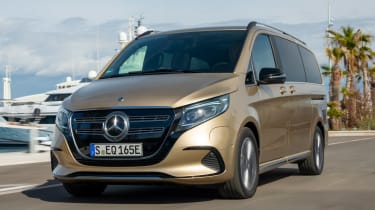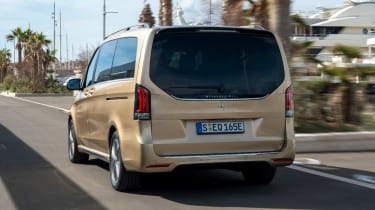New Mercedes EQV 2024 review: electric V-Class is classy but expensive
The updated Mercedes EQV offers a competitive range and is good to drive, but it all comes at a cost

Verdict
The Mercedes EQV’s niche positioning is growing even less relevant when you factor in its expected price. If you must have a seven-seat electric car, there’s a growing list of alternatives – most of which are much cheaper to buy. You’ll need to want a premium badge above all else to choose the EQV, even though driving experience is well-judged and the range is still competitive.
The EQV was Mercedes’ second model to bear the all-electric ‘EQ’ nameplate when it was revealed in 2019. Five years on, Mercedes has decided it's time to kill two birds with one stone by updating the V-Class and its all-electric EQV twin at the same time.
Mercedes’ hand may have been forced with the EQV’s refresh too, considering several new all-electric seven-seat offerings have arrived on the market recently. The Kia EV9, Volkswagen ID. Buzz LWB and the upcoming Volvo EX90 all pose an immediate threat. And that before you consider the Merc’s more immediate van-based rivals from Stellantis – the Peugeot E-Traveller, Citroen E-Spacetourer and Vauxhall Vivaro Life Electric – all of which have just received an update for 2024 as well.
As before, we’re only getting the 90kWh version of the EQV, with Mercedes saying there’s little appetite for the 60kWh model here in the UK. That’s probably just as well, because despite improvements to efficiency and range, the smaller battery offers just 172 miles of range. Thanks to better thermal management courtesy of a heat pump, UK cars now top out at 226 miles instead of 213 miles. That’s also nine miles more than the Stellantis trio.
More reviews
Charging speeds are unchanged, with a 110kW peak rate available. However, a revised charging profile means the top up from 10 to 80 per cent now takes 40 minutes rather than 45 minutes. The charging port located low down on the front bumper isn’t the worst layout we’ve come across, but it still feels like an afterthought.
The EQV drives the same as before, with no changes to the V-Class-derived chassis. We drove it back-to-back with the newly updated V-Class and what really stuck out was how much lighter the EQV’s steering was. The electric version also seems to wallow over speedbumps much more than the diesel.
There was a bit of tyre roar and wind buffeting, though that’s made more noticeable by the lack of powertrain noise. Overall, the EQV remains a surprisingly refined offering despite its rudimentary underpinnings.
A 201bhp/365Nm electric motor mounted on the front axle gives the EQV sprightly acceleration. It certainly feels quicker than the 12.1-second 0-62mph time suggests – especially around town where it’s particularly responsive. Three brake regeneration settings are offered and while they all differ in strength, even the most aggressive mode doesn’t allow for one-pedal driving. There are four pretty self-explanatory driving modes; ‘Maximum range’, ‘Range’, ‘Comfort’ and ‘Sports’.
The target audience for the EQV is “families, VIPs and leisure active people” according to Birgit Schramm, Senior Product Marketing for Mercedes. The EQV doesn’t get the eight-seat layout offered in the V-Class, but there’s room for seven, and you can even option the ‘VIP luxury seat’ option. But it’s up front where you’ll find the biggest differences compared with the old EQV.
Sitting in the driver’s seat, you’re met with two 12.3-inch screens that’ll be familiar to lots of Mercedes owners. The infotainment comes with the brand’s latest MBUX system, featuring the new ‘Hey Mercedes’ voice assistant. The maker says the assistant is now capable of more “dialogue and learning”; it can also determine which of the two front occupants are speaking and operate individual functions like heated seats based on this.
Our car was fitted with Mercedes’ augmented reality systems, which operates in conjunction with the onboard navigation system. A front-mounted camera feeds back an image to the central screen, overlaid on top of the sat-nav. It’s not ideal and is often distracting more than it is helpful. The blind spot detection system also had a tendency to panic, even when there wasn’t a vehicle nearby.
Final specification and pricing is yet to be announced for the EQV, ahead of its launch in the spring. Standard kit does look impressive on initial viewing however. There’s a new parking package, which includes active parking assist, rear-pedestrian warning and braking, plus a trailer manoeuvring assistant – though quite who will want to eat into the EQV’s range by towing a trailer remains to be seen.
The current EQV starts from £87,995, around double the price of its Stellantis rivals. We expect this new EQV will be subject to mild increase in price for 2024, which is at least accompanied by a modest uplift in technology and range.
The future of the EQV has been laid out by Mercedes’ upcoming Van.EA architecture, which is set to be introduced from 2026 and will underpin all vans from the German firm. Unlike the current V-Class and EQV MPVs, the new platform will come in two forms for ‘commercial’ or ‘premium’ use, with the former getting VAN.EA-C and the latter VAN.EA-P.
The hope is that this will create a greater difference between the two segments, and, in the case of the EQV’s successor, provide a more refined and luxurious experience.
| Model: | Mercedes EQV |
| Price from: | £90,000 (est) |
| Powertrain: | 90kWh battery, 1x e-motor |
| Transmission: | Single-speed automatic, front-wheel drive |
| Power/torque: | 201bhp/365Nm |
| 0-62mph: | 12.1 seconds |
| Top speed: | 87mph |
| Range/charging: | 226 miles/10-80% in 40 minutes |
| Size (L/W/H): | 5,140 mm, 2,249mm, 1,901mm |
| On sale: | Q2 2024 |






